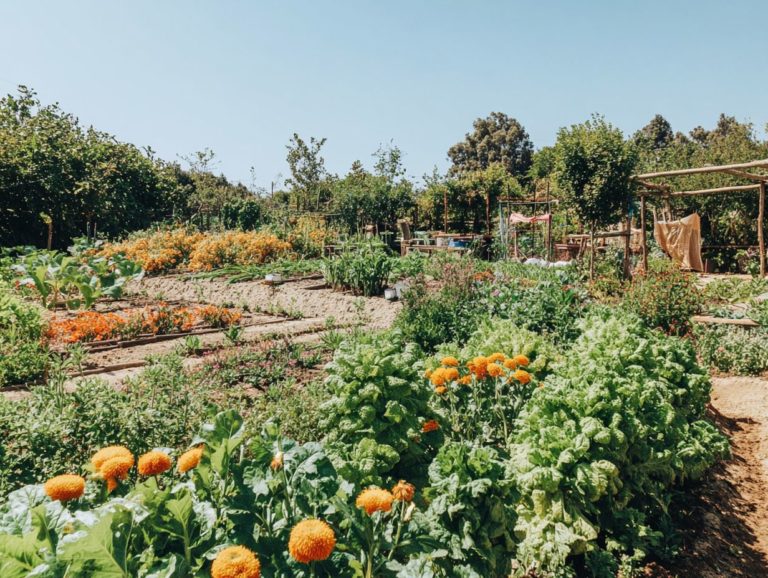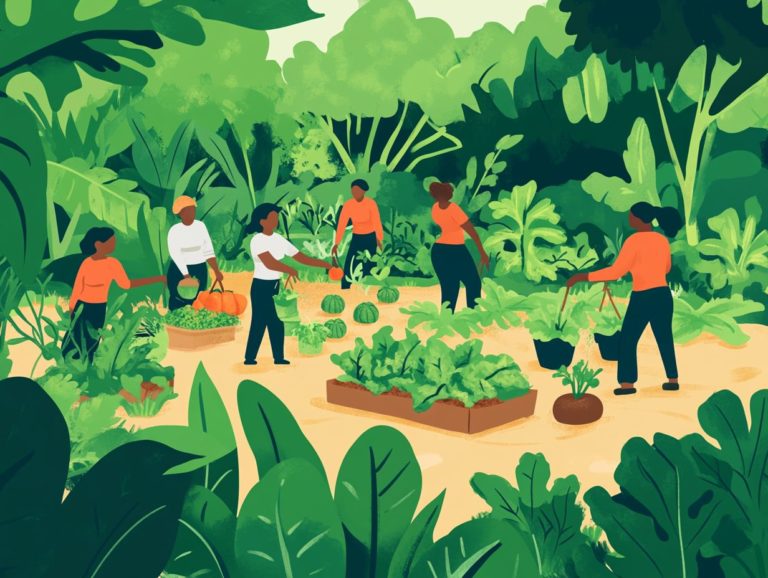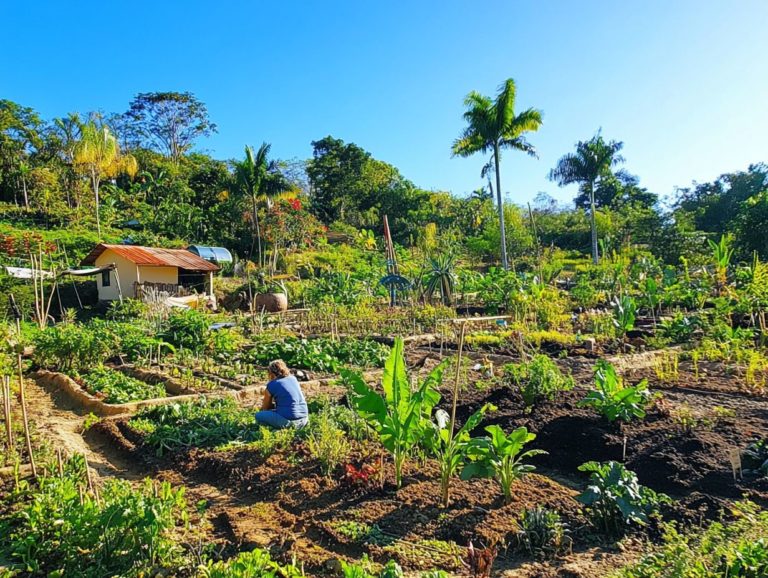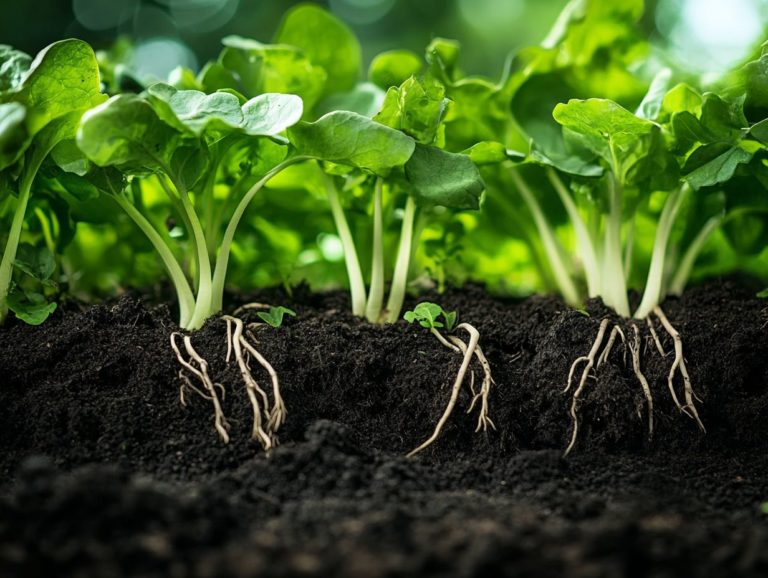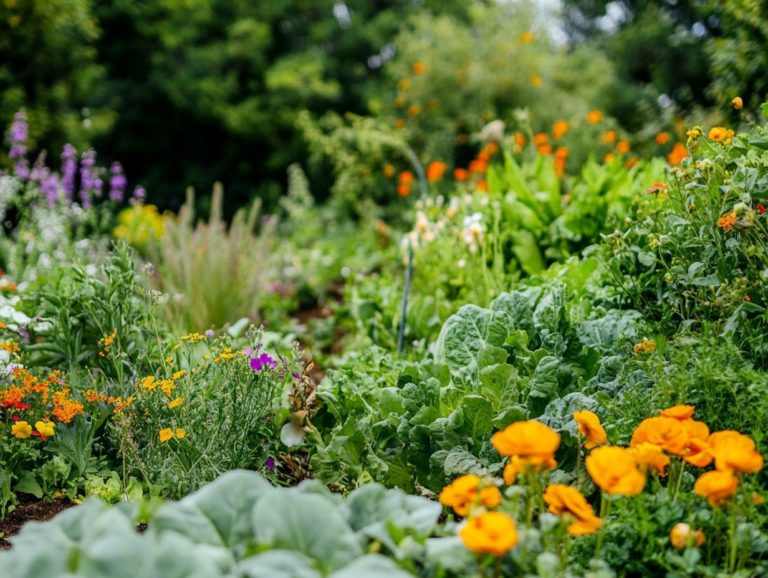What Are the Essential Elements of Permaculture?
Permaculture transcends the realm of a mere gardening technique; it embodies a holistic philosophy of sustainable living that aligns seamlessly with the rhythms of nature, promoting resilient ecosystems and a sustainable life.
At its essence lie three guiding ethics: Earth Care, People Care, and Fair Share. These principles help you care for the planet and its people.
Delving into the twelve principles of permaculture unveils practical strategies designed to foster resilient ecosystems and vibrant communities, enhancing food security and community sufficiency.
This guide will show you how to embrace these important elements, empowering you to cultivate a more sustainable future with confidence and purpose, integrating practices like urban farming and permaculture garden design.
Contents
- Key Takeaways:
- The Three Ethics of Permaculture
- The Twelve Principles of Permaculture
- Observe and Interact
- Catch and Store Energy
- Obtain a Yield
- Apply Self-Regulation and Accept Feedback
- Use and Value Renewable Resources and Services
- Produce No Waste
- Design from Patterns to Details
- Integrate Rather than Segregate
- Use Small and Slow Solutions
- Use and Value Diversity
- Use Edges and Value the Marginal
- Creatively Use and Respond to Change
- Frequently Asked Questions
- What Are the Essential Elements of Permaculture?
- Why is observation an essential element of permaculture?
- How does diversity play a role in permaculture?
- What is the significance of integration in permaculture?
- How does permaculture promote self-regulation?
- Are there any other essential elements of permaculture?
Key Takeaways:
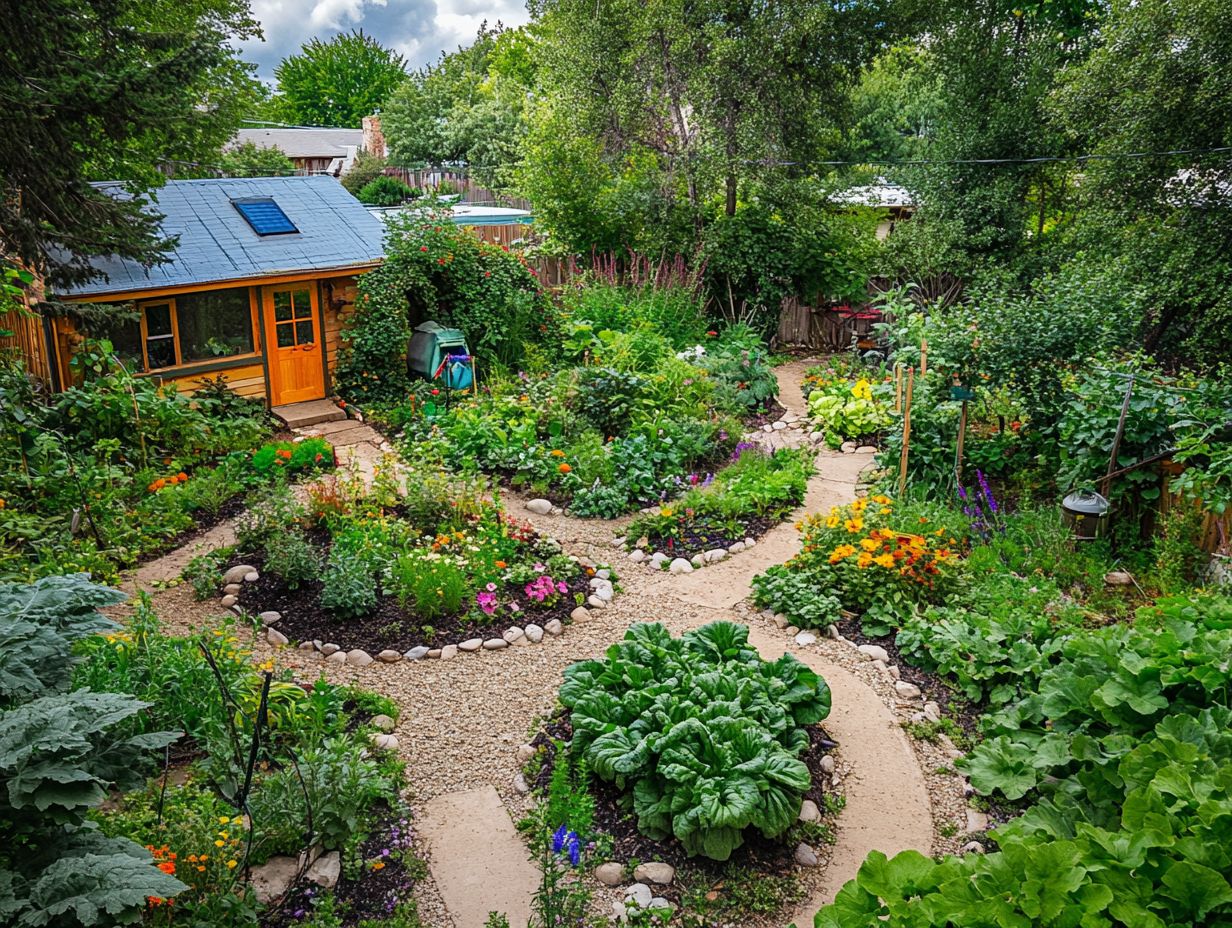
- Permaculture is a sustainable approach to living that follows three ethics: earth care, people care, and fair share.
- The twelve principles of permaculture, such as observing and interacting, using renewable resources, and valuing diversity, guide the design and implementation of sustainable systems, helping to extend the harvest season and produce no waste.
- Act now to apply permaculture principles! You can create more resilient and regenerative communities that work in harmony with the natural world.
What is Permaculture?
Permaculture offers you a holistic approach to designing sustainable systems that emulate natural ecosystems. It integrates agricultural practices, including urban farming, while emphasizing the ethics of people care, earth care, and fair share.
Pioneers like Bill Mollison and David Holmgren championed permaculture with the vision of creating landscapes where humans and nature coexist in harmony, employing techniques that enhance biodiversity and sustainability.
This innovative methodology took root in the 1970s, largely as a reaction to the environmental degradation caused by industrial agriculture and a rising consciousness about ecological balance. The founders underscored essential principles such as renewable resources and systems that recycle waste to create new resources, which aim to minimize waste and maximize efficiency, while employing strategies to catch and store energy.
By exploring Indigenous practices and traditional ecological knowledge, they aspired to build resilient agricultural frameworks that not only provide food crops but also restore ecosystems through practices like composting and the use of nitrogen fixers.
This historical foundation continues to shape modern sustainable agriculture, influencing communities around the globe and inspiring new generations to adopt ecological design in their pursuit of a healthier planet.
The Three Ethics of Permaculture
The three ethics of permaculture are your guiding principles for sustainable living and ecological stewardship. By embracing earth care, people care, and fair share, you lay a strong foundation for a practice that nurtures both the planet and community.
These concepts are essential tenets that elevate your commitment to a more harmonious existence with the environment and those around you, advocating for fair share and equitable distribution of resources.
Earth Care
Earth care embodies the ethical commitment to nurture and protect the planet’s ecosystems, emphasizing practices that enhance biodiversity, soil health, and the sustainable management of resources.
By embracing methods like composting, you can enrich the soil with vital nutrients and boost microbial activity, ultimately elevating the health of your crops while utilizing organic matter effectively.
Consider incorporating cover crops, which are a cornerstone of permaculture designs; they play a crucial role in preventing soil erosion, enhancing fertility with nitrogen fixers, and providing a haven for beneficial insects.
Integrating water features into your landscape not only aids in effective irrigation management but also supports local wildlife, enhances biodiversity, and enriches the overall aesthetic with edible flowers and beneficial insects.
Together, these practices contribute to vital ecosystem services, fostering a resilient and sustainable agricultural model that places earth care at its core.
People Care
People care is an essential element of a way of growing food that works with nature. It highlights the significance of building community relationships and enhancing food security.
By embracing sustainable practices, you can tackle food deserts head-on and encourage healthier lifestyles within your community. Community gardens exemplify how individuals can unite to grow fruits and vegetables while cultivating responsibility and a sense of enablement.
Educational programs covering gardening techniques and nutrition further amplify this mission. They equip participants with the knowledge to make informed choices and develop vital skills.
Collective efforts foster resilience, enabling communities to adapt and flourish in the face of environmental and societal challenges.
The principle of fair share encourages advocacy for the equitable distribution of resources. It emphasizes being a responsible steward of the Earth s wealth, ensuring future generations can thrive sustainably.
Implementing a range of strategies focused on sustainable practices helps you and your community work toward this ideal. For example, sharing surplus food minimizes waste while addressing hunger and showcases a commitment to social equity.
Engaging in community gardens and cooperative resource-sharing programs allows you to contribute meaningfully to your neighborhood. This nurtures a sense of responsibility and promotes food security.
By promoting ethical consumption and investing in local businesses, you enhance the balanced distribution of wealth. These actions foster resilience and sustainability.
Ultimately, embrace these collaborative efforts to help create a more fair and just world. Join us in this mission!
The Twelve Principles of Permaculture
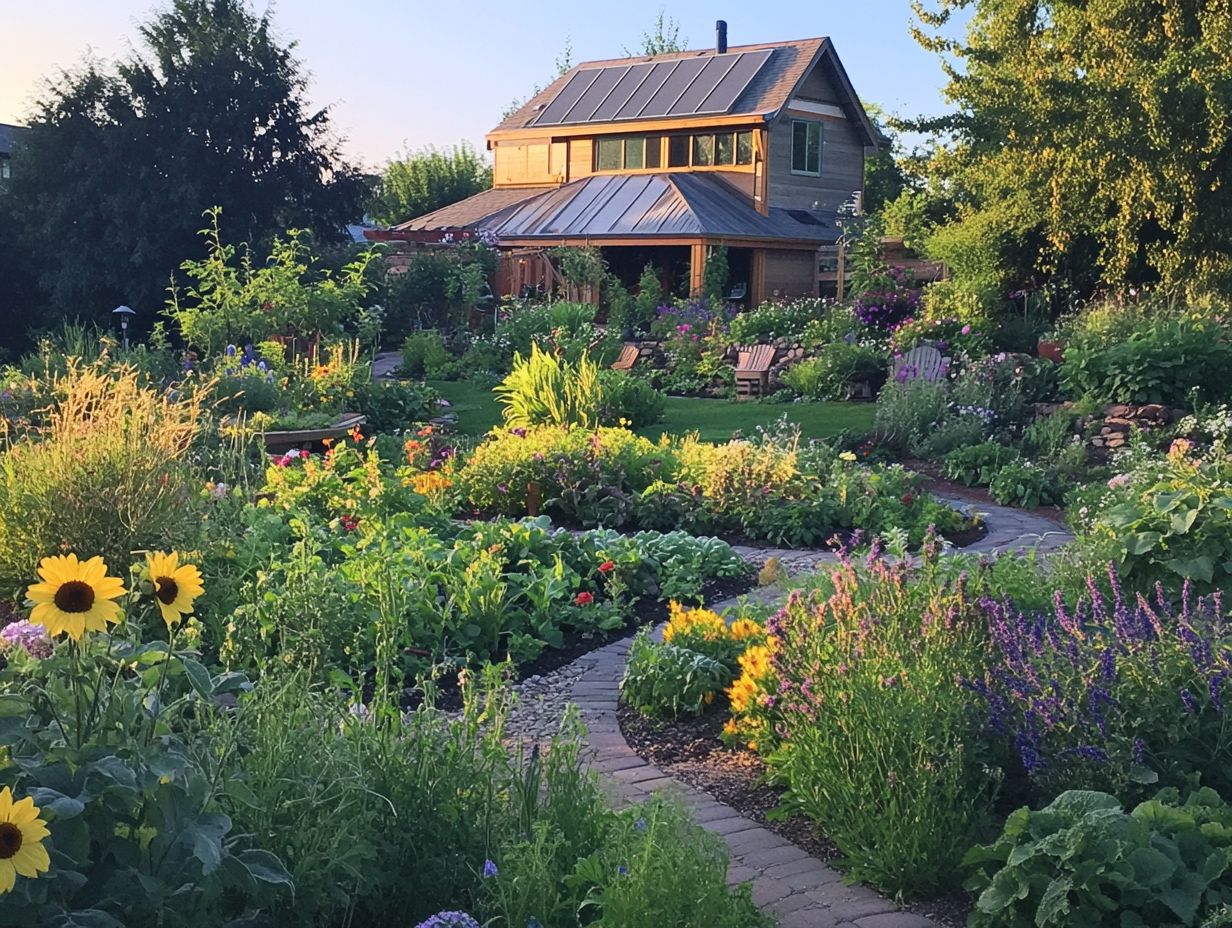
The twelve principles of permaculture offer a comprehensive framework for designing sustainable systems that align with nature. For those interested in implementing these principles, understanding the steps for creating a permaculture design can help incorporate design patterns that adapt to change.
By embracing practices like keen observation and interaction, capturing and storing energy effectively, and growing more food while wasting less, you cultivate an environment that thrives in harmony with the natural world.
Observe and Interact
The principle of ‘observe and interact’ invites you to study your environment and engage with ecosystems. This guides you toward better design decisions that enhance biodiversity and sustainability.
Adopting a keen observational approach provides insights into local ecological patterns, weather conditions, and soil health. This understanding profoundly shapes your efforts in fostering resilient habitats.
Engaging with the community is equally crucial. Collaborating with local gardeners, farmers, and ecological groups allows you to gather a rich tapestry of perspectives.
Employing techniques like ecological assessments enables effective monitoring of flora and fauna while community involvement fosters knowledge sharing. Together, you promote environmental stewardship and sustainability.
Catch and Store Energy
The principle of ‘catch and store energy’ emphasizes the importance of using renewable resources while maximizing energy efficiency through thoughtful design solutions like rainwater harvesting systems.
By incorporating practices like rainwater harvesting systems, you can effectively collect and store rainfall for future use. This significantly reduces your reliance on outdated water supply methods.
The adoption of solar energy systems not only supplies you with clean energy but also lowers your electricity costs. This showcases your commitment to sustainability.
This approach helps you and your community meet immediate energy needs while positively contributing to the environment. It promotes energy conservation and responds to energy decline.
Embracing these innovations paves the way for a more sustainable future. It illustrates how even minor adjustments in your design strategies can yield substantial benefits for energy conservation.
Obtain a Yield
The principle of “obtain a yield” highlights the importance of generating fruitful outcomes from your permaculture practices. This ensures that your food crops, medicinal herbs, and other resources enhance the well-being of the entire ecosystem.
To cultivate a diverse and flourishing garden, you can employ several strategies. Start by selecting a wide variety of plants that complement one another’s growth, including medicinal herbs and vegetables.
Embracing companion planting which means planting different types of crops together to benefit each other not only optimizes your space but also draws in beneficial insects like pollinators and pest predators. This helps keep pesky pests in check.
Enhancing soil health through practices like crop rotation, composting, and mulching enriches your soil with vital nutrients. This promotes vigorous plant growth.
Collectively, these strategies yield abundance and nurture a resilient ecosystem that thrives in harmony with nature, providing critical ecosystem services.
Apply Self-Regulation and Accept Feedback
The principle of ‘apply self-regulation and accept feedback’ invites you to embrace adaptability within permaculture systems. It fosters a culture of continuous improvement grounded in environmental feedback and ecological performance, which is essential for producing sustainable results.
This concept is crucial for anyone involved in ecosystem management. It encourages you to keenly observe changes in your surroundings and adjust your methods accordingly.
By actively monitoring indicators of health and sustainability, you can fine-tune your practices. This ensures that your systems remain resilient and productive.
This iterative approach cultivates effective feedback loops, allowing you to learn from past outcomes and make informed decisions.
Ultimately, by embracing this principle, you enhance ecological balance and contribute to a more sustainable future. It reinforces the interconnectedness of various components within the ecosystem, creating a harmonious relationship that benefits all.
Use and Value Renewable Resources and Services
The principle of ‘use and value renewable resources and services’ invites you to adopt sustainable materials and practices that minimize the depletion of our precious natural resources.
This approach is crucial! Integrating elements such as compost and cover crops into your gardening or farming practices enhances soil fertility and bolsters biodiversity while strengthening ecosystem resilience.
By utilizing compost made from organic waste, you can naturally nourish your plants. This reduces your reliance on synthetic fertilizers that may pose risks to the environment.
Meanwhile, cover crops serve as essential ground cover, preventing soil erosion and competing weeds while replenishing vital nutrients in the soil.
Together, these practices illustrate how the thoughtful use of renewable resources in permaculture cultivates a healthier environment and paves the way for long-term agricultural sustainability.
Start implementing these strategies today to make a difference!
Produce No Waste
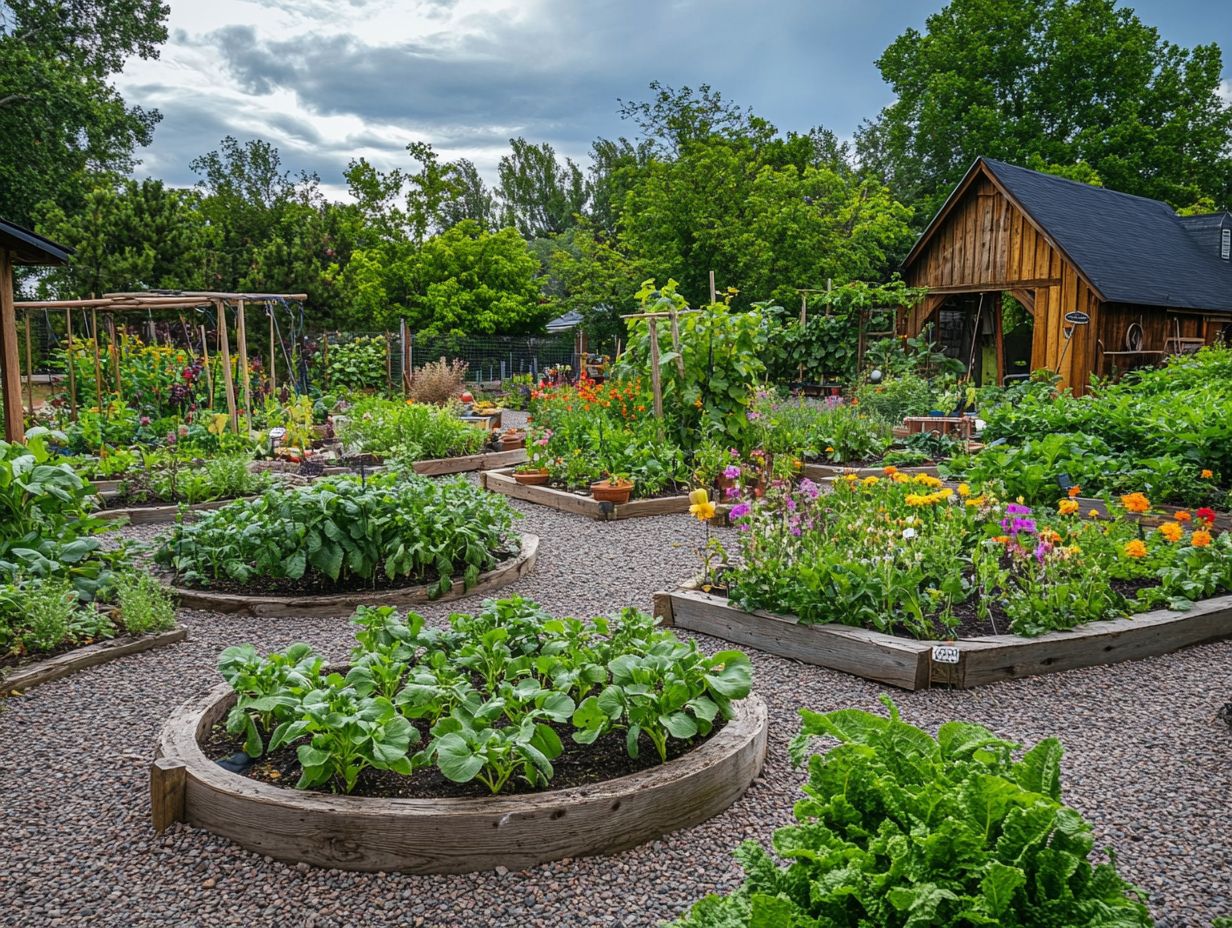
The ‘produce no waste’ principle emphasizes recycling resources. It aims to minimize waste in permaculture designs and establish closed-loop systems.
By joining resource-sharing projects, you can significantly elevate sustainability practices in your life and community! Composting diverts organic waste from landfills while enriching soil health and promoting biodiversity.
Similarly, joining tool libraries or community gardens encourages collaboration, reduces individual consumption, and cultivates a sense of ownership. These practical applications lessen your environmental footprint and allow you to actively contribute to a cleaner, greener future.
By emphasizing shared stewardship over resources, you strengthen local connections and foster sustainable living habits.
Design from Patterns to Details
The principle of “design from patterns to details” invites you to first recognize broader ecological patterns before focusing on finer details. This approach creates effective permaculture systems.
By observing interconnected relationships within ecosystems, you uncover fundamental elements like water flow, sunlight distribution, and plant interactions. These insights guide you in laying out a sustainable garden or landscape.
For instance, understanding wildlife behaviors and seasonal shifts in plant growth helps craft designs that boost biodiversity while reducing resource input. This holistic approach emphasizes collaborating with nature, leading to systems that are visually stunning and resilient!
Integrate Rather than Segregate
The principle of “integrate rather than segregate” encourages you to create interconnected systems. This fosters relationships among plants, animals, and community members, ultimately enhancing biodiversity and resilience.
This approach invites you, as a permaculture practitioner, to explore how to harmonize various elements within your designs. By establishing zones for interaction between species, you cultivate a more efficient ecosystem that promotes mutual benefits, like natural pest control and nutrient cycling.
For example, integrating pollinator-friendly flowers with your vegetable crops boosts productivity while supporting local wildlife. Involving community members in the planting and maintenance processes nurtures a shared sense of responsibility and connection, enriching the social and ecological fabric of your area!
Use Small and Slow Solutions
The principle of “use small and slow solutions” encourages you to implement gradual and manageable changes in permaculture design. This paves the way for more sustainable and easily maintainable practices.
By focusing on incremental adjustments, you can create systems that are resilient and adaptable to your local conditions. Take, for example, a community garden that starts with just a few raised beds; over time, it evolves to incorporate a variety of plant species, significantly enhancing biodiversity and food security!
Introducing aquaponics, which combines fish farming with growing plants, on a small scale allows you to use resources efficiently. These small-scale initiatives make a meaningful difference in resource management and cultivate community engagement, illustrating how collective efforts can foster thriving local ecosystems!
Use and Value Diversity
The principle of ‘use and value diversity’ highlights your opportunity to incorporate a rich variety of species and practices within your permaculture systems, enhancing both resilience and productivity.
By fostering biodiversity, you create a more stable ecosystem that enhances soil health and improves pest control. This approach also boosts crop yields.
For example, when you interplant legumes with staple crops, you’re fixing nitrogen in the soil. This cuts down on the need for synthetic fertilizers while promoting robust growth.
Integrating a range of herbs, flowers, and vegetables attracts beneficial insects, turning them into your allies in natural pest management.
Consider guild planting, where complementary species are grouped together. This approach showcases how diverse plantings can forge mutually beneficial relationships.
Not only does this strategy maximize your space, but it also supports food security and ecological balance essential elements in sustainable farming practices.
Use Edges and Value the Marginal
The principle of “use edges and value the marginal” emphasizes the productive potential of edges and marginal spaces within ecosystems, which typically demonstrate higher biodiversity and resilience.
These transitional zones like where forests meet fields or where water greets land create unique microhabitats that attract a diverse array of species. To tap into this potential, start by identifying these edges in your landscape.
Pay close attention to how the flora and fauna thrive in these areas. Incorporating a variety of plant species that excel in these transitional zones can boost productivity while nurturing ecological relationships.
Use techniques like companion planting and growing trees alongside crops to maximize yield, enriching both food production and natural habitats.
Recognizing and cultivating edge dynamics opens up a world of possibilities for a sustainable permaculture system!
Creatively Use and Respond to Change
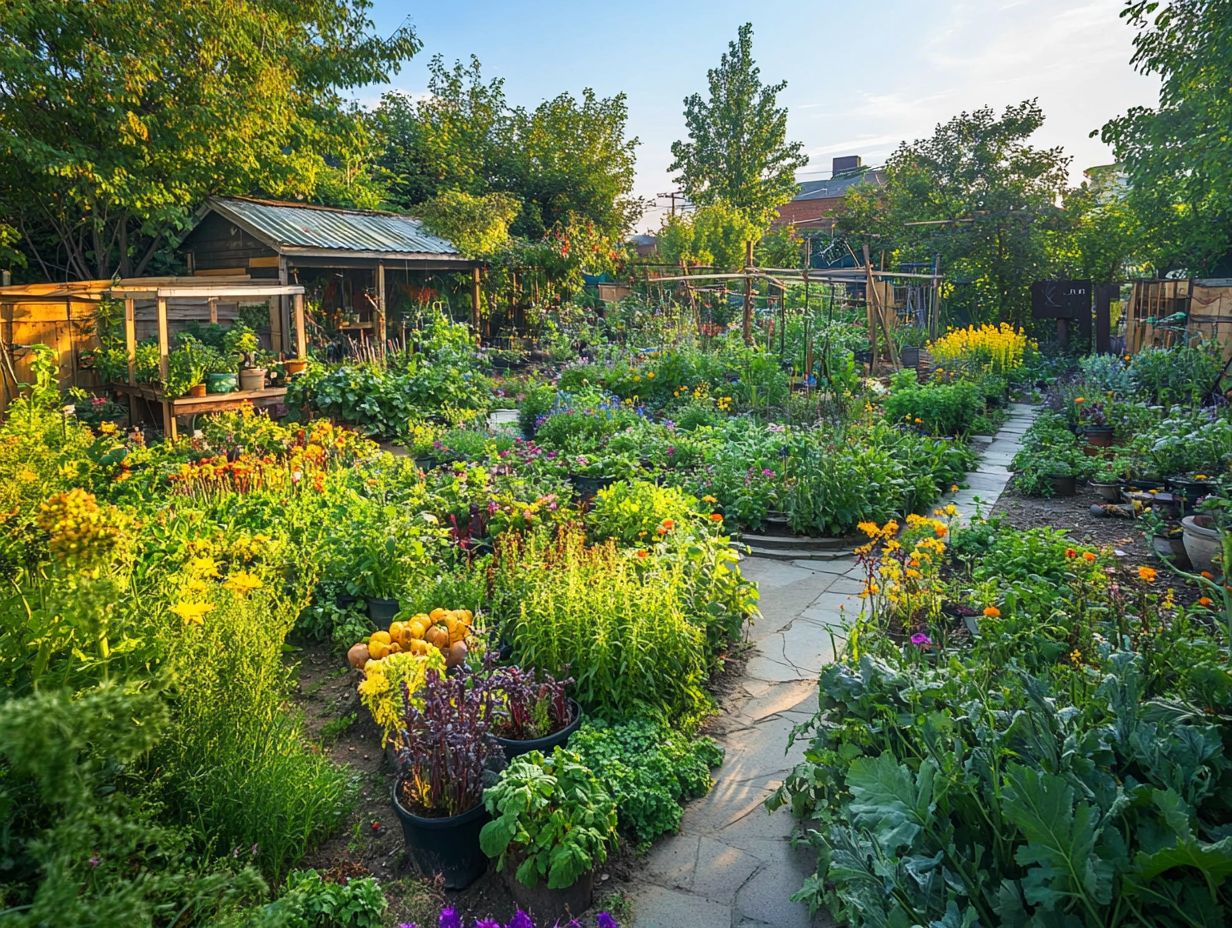
The principle of ‘creatively use and respond to change’ highlights the crucial need for adaptability in permaculture systems. This adaptability allows you to embrace environmental shifts and unexpected challenges.
This flexibility not only boosts resilience but also opens the door to innovative practices that can lead to sustainable solutions. By allowing for design flexibility, you can experiment with methods like integrating companion planting and vertical gardens, which optimize space and enhance biodiversity.
Engaging with local ecosystems deepens your understanding of natural cycles, enabling you to make informed decisions that align with seasonal variations and climate patterns.
Actively utilizing technology and gathering community feedback will ignite continuous improvements, ensuring your sustainable systems thrive amidst the ever-changing conditions and challenges you encounter.
Frequently Asked Questions
What Are the Essential Elements of Permaculture?
The essential elements of permaculture are principles and practices that guide sustainable and holistic living. To understand these better, it’s helpful to explore the principles of permaculture design, which include observation, diversity, integration, and self-regulation.
Why is observation an essential element of permaculture?
Observation is crucial in permaculture as it allows us to understand and work with nature’s patterns and cycles. It also helps us make informed decisions and design systems that are in harmony with the environment.
How does diversity play a role in permaculture?
Permaculture encourages diversity in all aspects, from plant and animal species to building materials and energy sources. This diversity creates resilience and stability in the system, making it more sustainable.
What is the significance of integration in permaculture?
Integration connects system elements for mutual benefit, like companion planting, which enhances growth and pest resistance.
How does permaculture promote self-regulation?
Permaculture designs aim to create self-regulating systems that require minimal human intervention. This is achieved by understanding and mimicking natural processes and cycles, allowing the system to function independently.
Are there any other essential elements of permaculture?
Yes, permaculture includes more than just the four main principles. It emphasizes using renewable resources, minimizing waste, and caring for people and the environment.
These principles guide us toward a sustainable and harmonious lifestyle. Embracing them can transform how we live!

